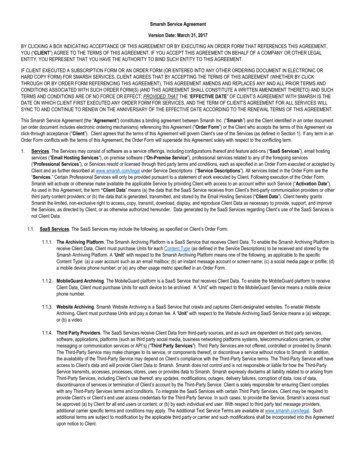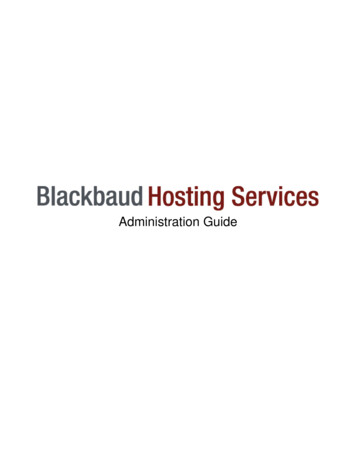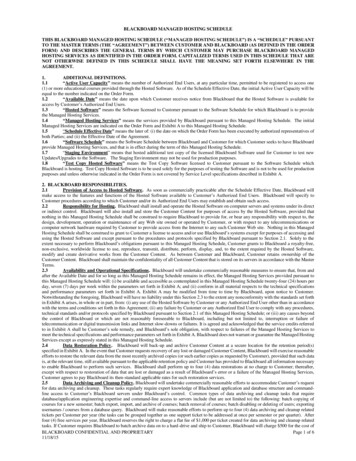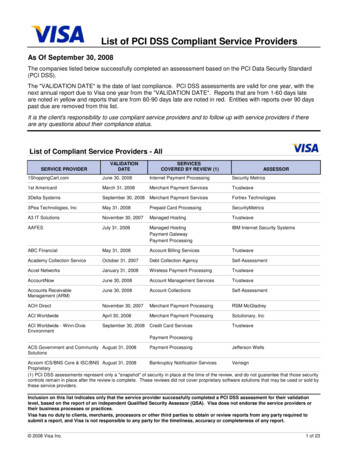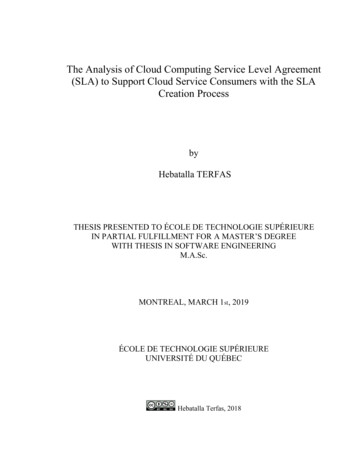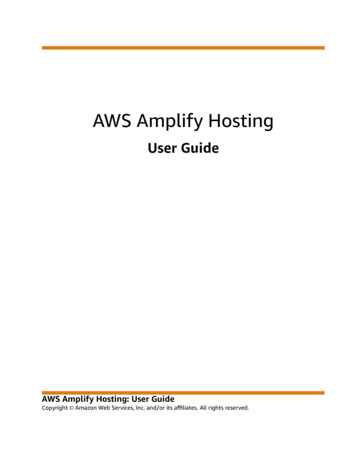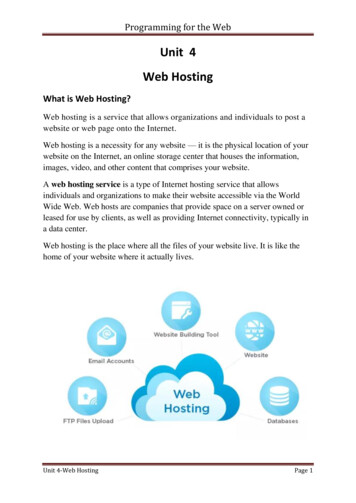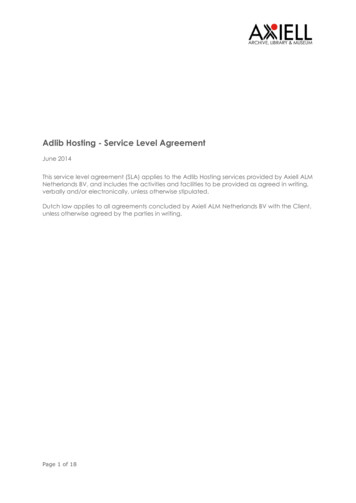
Transcription
Adlib Hosting - Service Level AgreementJune 2014This service level agreement (SLA) applies to the Adlib Hosting services provided by Axiell ALMNetherlands BV, and includes the activities and facilities to be provided as agreed in writing,verbally and/or electronically, unless otherwise stipulated.Dutch law applies to all agreements concluded by Axiell ALM Netherlands BV with the Client,unless otherwise agreed by the parties in writing.Page 1 of 18
Table of contents123Introduction . 4Definitions . 4General . 53.1 Precedent of agreements . 53.2 Contact persons . 53.3 General description of the services . 53.4 Duration of this SLA and hosting fee . 63.5 Account management structure . 63.6 Service Window . 73.7 Priorities table . 73.8 Maintenance Window . 73.9 Response times . 73.10 Backup and recovery procedure . 73.11 Maintenance, Planned maintenance, Emergency maintenance and Softwaredevelopment . 83.11.13.11.23.11.3Maintenance . 8Planned maintenance . 9Corrective maintenance . 93.12 Availability . 94Incident Management . 104.1 Objective . 104.2 Input . 104.3 Output. 104.4 Process and Actions . 104.5 Formal agreements between the Service Provider and the Client . 114.6 Contact . 114.6.1Calls . 114.7 Conditions and exclusions . 125Problem management . 125.1 Objective . 125.2 Input . 125.3 Output. 125.4 Process and actions . 12678Security . 13Data centre. 13Service Level Reports . 148.1 Operational Service Level Reports . 149 Ownership of data . 1510Exit procedure . 15Page 2 of 18
1112Appendix: Client specific parameters . 16Appendix: Description of Adlib Hosting configuration . 17Page 3 of 18
1 IntroductionThe aim of this SLA is to define further performance levels in addition to those described in theAdlib Maintenance Agreement SLA. The Adlib Maintenance Agreement SLA is also applicableto the Adlib Hosting services.2 DefinitionsAdaptive maintenanceAdditive maintenanceHardwareBackupAvailabilityOperating systemCallChangeContact personContractDatabaseRepair timeIncidentOffice hoursClient portalMonthMaintenance WindowNotificationAdlib softwareEmergency numberUnavailabilityMaintenanceForce majeurePerfective maintenancePage 4 of 18Proactive maintenance; the objective being to adjust componentsdue to external developments.Proactive maintenance; the objective being to supplementcomponents due to functional requirements.Equipment provided by the Client, or made available by the ServiceProvider to the Client, such as servers, PCs, network infrastructures andperipherals that are placed in the Service Provider’s network, and arefurther outlined in the agreement.Securing data by writing the data onto a back-up medium.Availability of the service.The operating system that runs on the hosting hardware.A notification made to the Service Provider help desk. This can relateto an incident, query, request, wish or complaint.An amendment.Persons appointed by the Client and Service Provider to act as thecontact person for all relevant issues regarding day to day hostingservice operations.The agreement concluded between the Client and the ServiceProvider.Collection of inter-related data provided by the Client that isaccessible via the applications used by the Client.The time period, measured and registered by the Service Provider,between the fault call and the finish call by the Service Provider to theClient (or the time at which the Service Provider endeavours to passon the call).An (imminent) fault detected in the agreed-upon service level of theservice provision.Work days between 09:00am and 05:00pm CET (GMT 1).myAdlib client web site.A calendar month.A predetermined period in which preventative maintenance isundertaken to prevent interruption to the service provision.A call.Collective name of the products and services package offered byAdlib Information Systems.The fault number to be called outside of business hours for faultnotification.The unavailability of the hosting service provided by the ServiceProvider to any single user as a result of an unscheduled incident.The undertaking of repairs, precautionary measures and regularchecks of the hardware installed, as well as planned maintenance.A situation that arises as a result of an incident which neither the Clientnor the Service Provider is culpable for, or (could) have exercised anyinfluence over.Proactive maintenance; the objective being performanceimprovement.
Preventative maintenancePriorityProblemAccessResponse timeService WindowSLASoftwareSoftware developmentFaultSystem environmentWork dayProactive maintenance; the objective being fault prevention.The order in which incidents, problems and changes are processed.An (imminent) structural fault in the agreed-upon service level of theservice provision.Products in the Adlib application range that relate to makinginformation on the internet accessible.The time period between a call made by the Client of an incident or aRequest for Change and the commencement of activities in relationto solving such an Incident or implementing such a Change.The time specification agreed with the Client in which the Client canutilise a service provided by the Service Provider.Service Level Agreement.The software installed and configured on the hardware by the ServiceProvider.Activities that relate to the design, creation, adaptation, expansionand testing of software.The unforeseen temporary or comprehensive failure of the serviceprovision to the Client.The total service package that enables the Client to use theapplications.Monday up to and including Friday with the exception of thegenerally accepted Dutch public holidays Good Friday, May 5th andDecember 31st. Office hours are from 9:00 to 17:00.3 General3.1 Precedent of agreementsOrder1234AgreementFramework AgreementLicense AgreementMaintenance Agreement (SLA )Adlib Hosting SLAIn the event of any conflicts or uncertainties arising in the aforementioned agreements, a higherranking agreement will prevail. The order of precedent of the various agreements is given in theabove table.3.2 Contact personsEach party will appoint a contract manager and fixed contact person. The contact details ofthe contract manager and contact person are shown in the contract. Changes to the contactdetails of the contract manager and contact person must be notified in writing.Operational communication will take place between the Client and Service Provider contactpersons, as much as is possible.3.3 General description of the servicesThis SLA relates to the services as outlined in the contract. This service includes the hosting ofAdlib back-office applications and/or the hosting of Adlib Internet Server web applications.Hosting and support of 3rd party products such as websites may, per the request of the Client,Page 5 of 18
also be hosted and supported at an additional fee. These products and services will be listed inappendix Client Specific Parameters.The hosting of Adlib back-office applications such as Adlib Archive, Adlib Library and AdlibMuseum, is configured in a Windows Terminal Server environment. The Client’s users (e.g. librarystaff) connect with the hosting server via Microsoft’s Remote Desktop Connection program. Formore detail on the hosting configuration see the appendix.The licenses for Adlib products are included in the service as mentioned in the Appendix ClientSpecific Parameters, unless specified otherwise.Standard disk space up to 100GB is included, unless otherwise agreed in the contract. This diskspace is allocated for the Adlib file storage and is exclusive of the space required for thedatabase.Initial disk space may be configured at less capacity and will be expanded per the Client’srequest.Additional disk space ( 100GB) can be configured at a fee.Server administration, including management of user accounts, and maintenance for all AdlibHosting servers will be carried out by the Service Provider.Microsoft licenses required for the hosting service are included in the service. This includesTerminal Server CALs, Windows CALs, MS SQL Server and MS Office. The Service Provider reservesthe right to change the hosting fee if Microsoft changes the fees for their products.The service includes the upgrading of the Adlib standard software to the latest versions.The Service Provider will do its utmost to make problem-free services available at all times. In theevent that a fault reduces availability the Service Provider is obliged to resolve the fault withinthe terms as stipulated in this SLA. The Service Provider is obliged to carry out regular checks andthorough maintenance of the hardware and systems provided, and to ensure that hardwareand system capacity is such that upon normal usage levels no faults occur.3.4 Duration of this SLA and hosting feeThe hosting period is for one year and will be invoiced in advance.The hosting SLA will be renewed automatically unless cancelled in writing at least two monthsbefore the end of the hosting period.The hosting fee will be index-linked to the Dutch Consumer Price Index at the start of each newhosting period.3.5 Account management structureMeetings can be arranged to take place at the request of one of the parties via the fixedcontact persons.Account meetings can cover the service provision at the operational level, work agreements,procedures, pending actions, outstanding issues, and other Adlib related issues.Meeting notes will be made available to the Client by the Service Provider.Page 6 of 18
3.6 Service WindowService Window as defined in this SLA.ComponentService WindowAdlib Terminal24 hours per day, 7 days per week (except for scheduled maintenanceServer: Adlib backwindows)office applicationsAdlib Internet24 hours per day, 7 days per week (except for scheduled maintenanceServerwindows)3.7 Priorities tableSpecification of priorities as defined by this SLA.PrioritySignificance1.ImmediateService provision failure2.HighPartial breakdown / reduced performance3.LowProblems with limited consequences for the Client3.8 Maintenance WindowMaintenance Window as defined in this SLA for scheduled maintenance.ComponentMaintenance WindowAdlib TerminalWork days outside of office hours (except for other agreed maintenanceServer: Adlib back windows)office applicationsAdlib InternetWork days outside of office hours (except for other agreed maintenanceServerwindows)3.9 Response timesResponse times as defined in this Immediate4 officehoursHigh4 officehours1 work dayLow1 work dayFor ServiceProvider todecideExplanationUpon incident notification the call is resolved withinthe applicable Service Window, within the responsetime solution timeframe.Upon incident notification the call is resolved withinthe applicable Service Window, within the responsetime solution timeframe.Upon incident notification the call is resolved withinthe applicable Maintenance Window, within theresponse time solution timeframe.3.10 Backup and recovery procedureData backup and recovery is taken care of by the Service Provider as follows:Page 7 of 18
ComponentMS SQL umSQL loggingApplication filesand digitalassets (images,documents,etc.)Every filechangen.a.Shadow copiesFull backupSeeappendixSee appendixFile system / SQL BackupsRetention periodThe SQL loggingallows a rollback ofthe database to aspecific moment intime. The retentionperiod is 1 month.Shadow copiesallow restoration ofdeleted files andprevious versions offiles.The retentionperiod is minimum 1month.Full backups arestored off site.The retentionperiod is 3 months.The Service Provider is responsible for the availability and reliability of these backup and restorefacilities.The Client can ask the Service Provider to restore their backup data. The Client and ServiceProvider will discuss the options and agree on the recovery procedures to be used. Invoicing forrecovery procedures will (based on the standard hourly rate at that time) occur on the basis ofhours spent, should the Client be responsible. If the need for a restore is the Service Provider’sresponsibility, then the restore will not be invoiced.3.11 Maintenance, Planned maintenance, Emergency maintenance andSoftware developmentFor all the vital components of the Service Provider’s central infrastructure preventative andplanned maintenance will be carried out within the maintenance windows, to ensure thatservice interruption is kept to a minimum.The Service Provider may agree with the Client on an alternative maintenance window, on acase by case basis.3.11.1 MaintenanceIn its service-related maintenance activities the Service Provider aims to minimise the noticeableeffects on the service provision experienced by the Client as much as possible, by adopting thefollowing measures: Important transactions are carried out during the maintenance window as much as ispossible;Maintenance activities that the Client will notice are kept to an absolute requisite minimum;Maintenance activities will be combined as much as is possible.During maintenance activities the service provision may be noticeably affected (priority levels 2or 3); the Service Provider will do its utmost to prevent service failure (priority level 1).Page 8 of 18
3.11.2 Planned maintenancePlanned maintenance (preventative, perfective, adaptive and additive) to the network, serversand other relevant infrastructural matters can occur at any given time. The Client will be notifiedin advance. It is possible that during this maintenance period the hosting service will becomewholly or partially unavailable to the Client (priority level 1: service failure).Notification of planned maintenance will be communicated at least 24 hours prior to workcommencing, and will contain the following information: Contact person details;Timeframe within which the planned maintenance will occur;Actual expected duration of the planned maintenance;The services which the planned maintenance will affect;Prioritisation.Planned maintenance is not included in availability calculations unless the period for theplanned maintenance is exceeded and the hosting service becomes unavailable to the Clientas a result.3.11.3 Corrective maintenanceCorrective maintenance may be necessary when circumstances require immediateintervention. In such a situation notification will be given to the Client as soon as possible.Unavailability during emergency maintenance is included in the availability calculation.Software developmentIf upon the request of the Client software development is carried out on Service Providerproducts which in turn results in reduced availability, this will not be included in availabilitycalculations. A test environment can be set up upon request. The setting up of client-specifictest environments may incur additional costs. The initial configuration of a test environment onthe same server(s) as an exact copy of the production system is included in the Hosting SLA.3.12 AvailabilityA guarantee applies to the availability of the hosting environment, as indicated on a monthlybasis in the table below.The Service Provider does not guarantee constant communication over the internet, or that aconnection can always be made with another piece of hardware connected to the internet. Byunavailability it is understood to mean if a hosting service provided by the Service Provider is notusable to any users at all due to an unscheduled event. If a service is unusable to a certainnumber of users, or does not function properly, then this is understood to mean an incidentwhereby the service itself is reported to be available.The responsibility of the Service Provider with regard to availability, such as formulated in this SLA,does not apply to faults if: Planned activities are carried out;The fault occurs as a result of a fault in the telecommunication structure of third parties;A breakdown is caused by a Client Request for Change;A breakdown is caused by changes made by Client personnel to the Service Provider’shardware, platform or Adlib configuration;Force majeure prevails.Page 9 of 18
Service availability (A) is calculated, at one or several locations, as follows:A 100% * [1 – (t: T)]t the number of minutes the service was unavailable during a given month (service failure)T total number of minutes per monthTotal unavailability (HH:MM:SS)Per dayPer month00:04:1902:09:30Availability99.7%Per year25:54:004 Incident Management4.1 ObjectiveThe objective of Incident Management is to resolve faults in the service provision to the Client asquickly as possible. Client interruption to work must be kept to a minimum, and resumption tonormal activities must occur as quickly as possible.This is achieved by accepting, registering, assessing, solving and concluding Client calls via theclient portal and help desk.4.2 InputClient notification via the client portal runs from the Client contact person to the Service Providerhelp desk.The call must contain the following components: Name of the person reporting the call;Telephone number and email address of the person reporting the call;The date (possibly time too) the Incident occurred;Description of the incident;Module where the incident occurred;An estimated priority by the Client.4.3 OutputUpon receipt the call progress can be tracked on the client portal.4.4 Process and ActionsProcess stepRegistration&ClassificationPage 10 of 18DescriptionResultActioned byThe Client is heard; the call isinterpreted and registered in theclient portal.Call is diagnosedService Provider
Investigation& InitiationResolution &RepairConclusionThose responsible for finding asolution are allocated. The Client isinformed of the proposed resolutionaction. The person responsible maybe:1. The Service Provider;2. Another party; it may also be aparty whom the Client has anagreement with;3.The ClientService Provider responsible: theaction is carried out in accordancewith Service Provider procedures.Other Parties responsible: theaction is no longer covered by thisSLA; the Service Provider shall passthe call on to the third partyresponsible for resolving theproblem. Monitoring progress is theresponsibility of the Service Provider.The Client responsible: the action isdiagnosed as the responsibility ofthe Client and not covered by thisSLA. The Client should be able toresolve the issue.When the incident has beenresolved, it is closed on the clientportal.Solution action isdetermined andissuedService ProviderService Provider, ThirdPartiesIncident isresolvedCall is closedService Provider4.5 Formal agreements between the Service Provider and the ClientService LevelResponse timeStandardTimes are determined by priority (see the priority table explanation, section 3.7 ofthe SLA).4.6 ContactThe various contact options for an incident report are listed in the tables below:4.6.1Priority123CallsMethodVia the help desk phone numberVia general phone numberVia client portalVia help desk e-mailVia the help desk phone numberVia general phone numberVia client portalPage 11 of 18
Via help desk e-mailVia the help desk phone numberVia general phone numberDuring office hoursHelp desk direct phone number:General Adlib phone number: 31 346586801 31 346586800Any timeHelp desk e-mail: ALM.NL.helpdesk@axiell.comClient portal:http://my.adlibsoft.com/4.7 Conditions and exclusions The Service Provider is not available outside of office hours, unless otherwise agreed.Calls submitted outside of office hours are processed on the following work day.All calls caused through repeated or systematic improper use by Client employees are to beimmediately communicated to the Client.Calls that, upon consultation with the Client, are placed on hold are not covered by theagreed-upon Service Levels, until the status is changed upon consultation between theClient and the Service Provider.The Client must ensure that in its contracts with third parties the Service Provider is informedabout the status and progress of any calls referred to these parties.5 Problem management5.1 ObjectiveThe objective of problem management is to improve service provision quality by investigatingthe cause of incidents and to resolve them. In other words: the objective of problemmanagement is the structural resolution of incidents, and to learn from them.5.2 Input Incident list per category.5.3 Output Upon commencement a call is reported to the ClientA resolved problemPotential further progress reports regarding the problem5.4 Process and actionsProcess stepRegistration&ClassificationPage 12 of 18DescriptionResultActioned byThe input (see above) is assessedand interpreted. Subsequently aProblem isdeterminedServiceProvider
Organisation& InitiationAnalysisConclusion‘Problem Record’ is created in thesystem with a priority code.Prior to resolving a problem aproposal is determined and issued.The problem is investigated inaccordance with the proposal andthe cause is investigated; wherenecessary in conjunction with thirdparties. The impact and risk of thepotential change are analysed.Communication with the Clientmay occur if they need to becomeinvolved.If the problem can be resolved achange is implemented.Proposal isdetermined andissuedCause of theproblem isinvestigatedServiceProviderProblem is resolvedServiceProviderServiceProvider /Client6 SecurityThe Service Provider recognises the importance of securing the client’s data. In order toguarantee optimum security both the Service Provider and the Client will undertake thefollowing measures: The Service Provider provides SSL certificates for the hosting servers.The Client is responsible for the persons they have authorised to have access to the softwarethat is part of the system environment, as well as the applications.The Service Provider will consider which employees are authorised to adjust authenticationsand authorisations in the Client’s environment.If a server is hit by a security incident the Service Provider will consider what the subsequentprocedure will be, if necessary patches will be installed in the short-term. If as a result theService Provider’s service is interrupted the Client will be notified of this immediately.In the event of serious security problems – either to hardware or software – the ServiceProvider will consider what the subsequent procedure will be. If necessary, patches will beinstalled in the short-term. If this transpires to be insufficient the Service Provider will, uponconsultation, proceed to reinstalling the server. If as a result the Service Provider’s service isinterrupted the Client will be notified of this immediately.The Service Provider provides no guarantees and accepts no liability with regard to thesecurity of network connections and stored data. The Service Provider will do its utmost toprevent unauthorised physical and logical access to data, and to keep the Client’sinformation confidential.7 Data centreThe Service Provider uses a green (sustainable) data centre that is built compliant with Tier IIIspecifications of the TIA-942 data centre standard. The following applies: Data centre supplier is ISO9001, ISO27001, ISO14001 and NEN7510 certified.Redundant power supplyAdvanced climate system that minimizes deviation in temperature and humidityEmergency power supply: UPS and generatorGreen (sustainable) power is usedPage 13 of 18
Double power feeds to racksEach rack has its own UPSEach rack has its own ATS (Automatic Transfer Switch)Green (sustainable) adiabatic climate systemFloor humidity detectionAll Adlib Hosting server hardware and storage hardware is owned by the Service Provider.Physical security is organised as follows: 24/7 surveillance of the datacentre.Access control by security tags and finger prints.Fire detection- and automatic fire extinguishing systemAccess to the server area is limited to system administrators, IT manager and director.Floor humidity detection system reports direct to the security provider.The data centre is owned by Eurofiber BV and located at Kon. Wilhelminaweg 471 atGroenekan, The Netherlands.8 Service Level Reports8.1 Operational Service Level ReportsRelevant information is made available via the client portal. An extended report based on thisdata can be compiled upon request.CategoryIncidentsDescriptionOverview of total number of reported incidents for the period in question,with: priority;description;status;lead time.CategoryDescriptionProblemsTotal number of created and/or reported problems for the period inquestion, with: CategoryPage 14 of 18priority;description;status;lead time.Description
l environment percentage availabilityDescriptionOverview of security incidents given in: description;status.9 Ownership of dataAt all times, the Client will remain the owner of the data that is stored and managed in the Adlibdatabases. The Client will have full custody over the content of their Adlib database and Clientspecific digital assets such as images and electronic documents.10 Exit procedureUpon terminati
Agreement 1 Framework Agreement 2 License Agreement 3 Maintenance Agreement (SLA ) 4 Adlib Hosting SLA In the event of any conflicts or uncertainties arising in the aforementioned agreements, a higher ranking agreement will prevail. The order of precedent of the various agreements is given in the above table. 3.2 Contact persons



